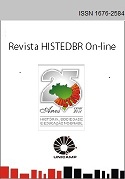Resumen
From 1870 to 1930, physicians, writers, anthropologists and educators discussed therelationship between education and the less-privileged segments of the Brazilianpopulation. Among ideas circulating in the late nineteenth century were precepts of SchoolHygiene, such as physical exercise could promote personal health and, in a broader sense,the total development of the child. In discussions of eugenic themes in the early decades ofthe twentieth century, Physical Education was further promoted as a corrective measure forthe negative effects of miscegenation; that is, the physical, intellectual and moral debilitiesof the poor and non-white segments of the Brazilian population. This paper examines thenature and effects of the school discipline Physical Education on the less-favored childrenof Brazil by first introducing its role in School Hygiene and then by focusing on itsextended role from the eugenic perspective. In this latter discussion, the racial ideas ofFernando de Azevedo regarding the regenerating effect of Physical Education on the“Brazilian Race” are explored.Citas
ADAMS, M. “Eugenics in the History of Science” In: ADAMS, M. The Wellborn Science: Eugenics in Germany, France, Brazil, and Russia. New York: Oxford University Press, 1990
AZEVEDO, F. Da Educação Physica: o que ella é – a que tem sido – o que deveria ser. São Paulo: Weiszflog Editores, 1920.
AZEVEDO, F. Novos Caminhos e Novos Fins. A Nova Política de Educação no Brasil. SP. Melhoramentos, 1932.
AZEVEDO, F. “O problema da regeneração”. Revista Educação Physica, 1933, no. 5
BARBOSA, R. Reforma do ensino primário e várias instituições complementares da instrução pública. Rio de Janeiro: Fundação Casa de Rui Barbosa, v. X, tomo IV, 1982.
GONDRA, J. “Medicina, higiene e educação escolar.” In: LOPES, E.M.T.; FARIA FILHO, L.M. & VIEGA, C.G. 500 anos de educação no Brasil. Belo Horizonte: Autentica, 2a edição, 2000.
LIMA, N. T. & HOCHMAN, G. “Condenado pela raça, absolvido pela medicina. O Brasil pelo movimento sanitarista da Primeira Republica”. In: Maio, M C. & Santos, R. V. (orgs). Raça, ciência e sociedade. Rio de Janeiro: Fiocruz, Centro Cultural Banco do Brasil, 1996.
LORENZ, K; VECHIA, A.; FERREIRA, A. “Hygienization” and the Schooling of the Less-Privileged Classes in Brazil, 1880-1920. Paper presented at the 30th Session of the International Standing Conference for the history of Education (ISCHE). Rutgers University, Newark, New jersey, July 2008.
MASIERO, A. “A psicologia racial no Brasil (1918-1929)”. Estudos de Psicologia, 10(2), 2005.
MONCORVO FILHO, C. A. Histórico da protecção à infância no Brasil 1500-1922. Rio de Janeiro: Impreza Graphica Editora, 1926.
ROMERO, S. America Latina. Porto: Livraria Ohardon, 1906.
SCHNEIDER, W. The Eugenics Movement in France. In: ADAMS, M. The Wellborn Science: Eugenics in Germany, France, Brazil, and Russia. New York: Oxford University Press, 1990,.
STEPAN, N. Eugenics in Brazil: 1917-1940. In: Adams, Mark. The Wellborn Science: Eugenics in Germany, France, Brazil, and Russia. New York: Oxford University Press, 1990.
VECHIA, A; LORENZ, K. Fernando de Azevedo e a questão da “raça brasileira”: sua regeneração pela educação física. Cadernos de Historia da Educação. Uberlandia, Editora da Universidade de Uberlandia, Brazil, vol. 8, no. 1, jan-jun, 2009, pp. 57-70.
ZUCOLOTO, P. C. S. V. O médico higienista na escola: as origens históricas da medicalização do fracasso escolar”. Revista brasileira de crescimento e desenvolvimento humano. São Paulo, v. 17. no. 1, abr. 2007.
A Revista HISTEDBR On-line utiliza a licença do Creative Commons (CC), preservando assim, a integridade dos artigos em ambiente de acesso aberto.

